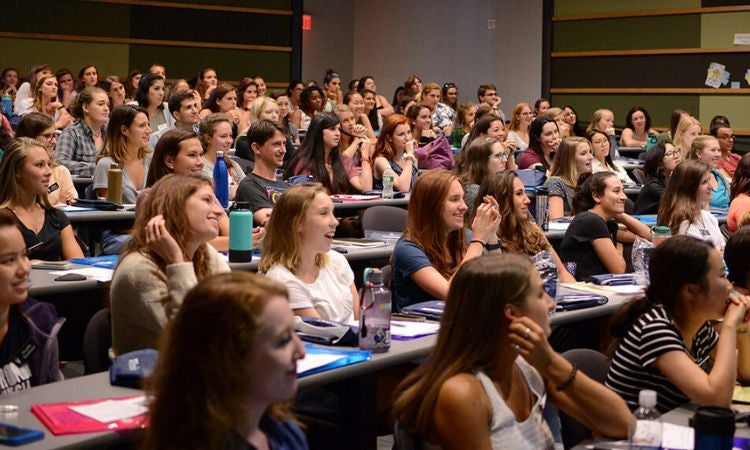Tuition and Aid
Cost of Attendance: Tuition, Fees & Expenses
The total cost of attending Penn Vet includes tuition, fees, and estimated expenses for books, supplies, and room and board. There are also miscellaneous costs for such things as personal items, loan origination fees, and health insurance premiums. (Health insurance is mandatory for all Penn Vet students.)
All students, whether recently admitted or currently enrolled, should create a workable budget for tuition and educational fees, as well as living expenses and other costs incurred during their time as students.

Explore the Cost of Attendance
Review the costs for the most recent academic year.
Financial Aid
We at Penn Vet understand that affording your education can seem daunting. We are committed to helping you every step of the way — through budget plans, loan applications, the latest scholarship information, and more. Friends and alumni of Penn Vet play key roles in supporting student scholarship aid to help reducing our students’ debt.
Federal Loans
We advise you to apply for a federal student loan as soon as you have accepted Penn Vet’s offer for admission. For students interested in learning more about federal loan options visit the Student Registration & Financial Services website.
Penn Vet Scholarships
School-based scholarship funding is limited. Most Penn Vet students finance their veterinary education primarily through loans. There are some exceptions, however, which are outlined below. Please read through these to see if any might be right for you.
Recruitment Scholarships
We use Recruitment Scholarships to attract exceptionally qualified students who will play important roles at Penn Vet and, later, in the veterinary profession. We award these scholarships to applicants who: show great potential for veterinary school; have plans for the future that they have begun to realize; and take a global approach to the practice of veterinary medicine. We seek students who will add diversity to their class, our school, and Penn; come from normally unrepresented regions of the U.S. or the world; have different cultural backgrounds; and demonstrate unusual or atypical interests.While grades are important, these are not the only deciding factors in the selection process for these awards, which are used to secure highly academically capable students and ones we otherwise might not attract. Email admissions@vet.upenn.edu for more information.
Opportunity Scholarships
Opportunity scholarships of $32,000 ($8,000 per academic year) are available for matriculated first-year students. Award recipients are selected based on academic merit and interests, extracurricular activities and financial need during the second semester of the student”s first year. Winners of these scholarships are also paired with mentors who work closely with them all during their years at Penn Vet.
Merit Scholarships
Continuing students are eligible for annual Merit Scholarships, which are made possible by generous donations from the Penn Vet community. The frequency and number of these scholarships depends on available funding. The minimum award amount for each one is currently $5,000. Contact our office for more information.
Outside Scholarship Resources
This list can be used as a starting point. The best way to keep up with scholarships and deadlines is to follow these and other clubs & organizations on social media.
AAVMC & AVMA
- Association of American Veterinary Medical Colleges
- American Veterinary Medical Foundation
Areas of Study
- American Kennel Club Veterinary Outreach Scholarship
- American Association of Swine Veterinarians
- American Association of Avian Pathologists
Corporations
Private Foundations
- William Goldman Foundation Scholarship- Applications are mailed to the the Students Affairs Office each year and students will be notified
- Dorothy Havemeyer Foundation
State Organizations
- Pennsylvania Veterinary Medical Association- Animal CarePA
- New Jersey Veterinary Foundation
- Vermont Veterinary Medical Association Foundation, Inc.
- The New Hampshire Veterinary Medical Association
- The Maine Veterinary Education Foundation (MVEF)
USDA
- Saul T. Wilson, Jr., Scholarship Program (STWJS)
- Adel A. Malak Scholarship
The FAFSA
Free Application for Federal Student Aid
All students MUST submit a Free Application for Federal Student Aid (FAFSA) form between January 1 and May 1 each year at: www.fafsa.ed.gov. The FAFSA Code for the University of Pennsylvania is 003378. A FAFSA must be completed and filed every year in order to receive Federal Direct Loans.
Meet the Financial Aid Staff

Nichole Davis Moore
Director of Scholarships & Financial Aid

Kristin E. Mozzachio
Student Financial Aid Coordinator
Nichole and Kristin can help you navigate the at-times confusing landscape of financing your education. They are a part of your Penn Vet Admissions team!
(215) 898-4840
Private Loans
For more detailed information about Graduate/Professional loans, review Penn’s Student Financial Services web page.

Budget
Paying for Your Education
All students, whether recently admitted or currently enrolled, should create a workable budget for tuition and educational fees, as well as living expenses and other costs incurred during their time as students.
